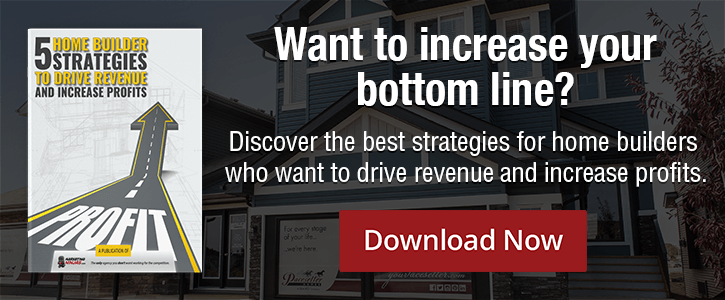Assessing Your Expenses: Why You Need to Rethink the Way You Look at Marketing
It often seems like the marketing department takes up a huge portion of the budget, and you just can't see how it's working to help you sell more homes.
It feels like a big mark in the expense column of your accounting ledger.
But what if we told you it didn't have to be that way?
Marketing is necessary, this we all know. But it doesn't have to be this big, evil thing that shrinks your profit margins.
When done right, marketing becomes a solid investment for your home building business, giving you a positive return (ROI) each and every month.
Reading time: 5 minutes
Level: Intermediate
Key takeaways:
Want to know how?
Marketing Shouldn't Cost Money, It Should Make It
Let's say I ask you for $1,000 and, in one month, I will give you back $2,000. No catches, no tricks.
Who wouldn't take that deal?
This is how it should work. And, if you have a solid marketing strategy (and are working with a great agency, *wink*), this is exactly what will happen. Yes, initially you need to part with some money, but knowing that you're going to see a positive return on the investment makes it pretty easy to do.
And while not every piece of your marketing budget will do that, if at the end of the day you're coming out on top, how can it be called an expense?
Two different scenarios for you (note - we're using smaller numbers here for simple math; we understand most marketing budgets don't fall into this range!):
- You pay $1,000 for a billboard campaign, and from that, you earn $1,500. You have an ROI of 50%. But once that campaign is done, that's it. This would be an expense.
- You decide to make a marketing investment into an inbound program with an initial cost of $1,000. From that cost, you earn $1,500. You've gotten an ROI of 50%. However, because you've invested in an ongoing program, that first investment continues to bring you money, month over month. So over time, your ROI goes up. This is an investment.
 It's All About the Data
It's All About the Data
Expenses suck. Investments don't.
When you take the investment approach with your marketing, you see where your money goes and how it's bringing in more home sales, which in turn gives you higher profits.
The key thing to any good investment?
Data.
Without data, you don't know anything. When you're looking at a new stock option, you read about it, learn about it, gather all the information you can.
The same goes for your marketing.
Which marketing campaigns are showing successes? How? What activities are your marketing team doing that you can track? Where can you pull that all-important data from? You need marketing analytics to see what is and isn't working.
If you can see Campaign X brought in 10 new deals over three months, but Campaign Y yielded squat, which one are you going to want to continue with?
A key thing to keep in mind is if you can't measure it, you shouldn't be doing it. Everything you put into your marketing budget should be measurable. Because if you can't track and analyze the data, how do you know it's working?
 ROI is Your Key Measurement
ROI is Your Key Measurement
When you choose to focus on the ROI of your marketing campaigns, it makes it much easier to keep your marketing campaigns on track and on budget.
When the market is in a slump, many home builders choose to slash marketing budgets - which is a risky move. By looking at your marketing dollars as an investment - one specifically targeted to help sell more homes (AKA increase revenue) - you can see how this is not the smartest play.
Best Case Scenario
You measure and track all of your marketing investments, and calculate the ROI you're making. Because you're keeping track of all the data, your campaigns continue to deliver high returns AND you're able to improve them. Since your campaigns are doing so well, and you have the data to back up your investments, everyone is happy!
Neutral Case Scenario
Sometimes you look at and analyze the data, sometimes you don't, which leads to incomplete information and not being totally sure how your campaigns are doing. You end up with a general idea, an overview if you will, of what kind of ROI you're getting but no way to really determine specifics or find areas for improvement. And because you can't provide specifics, your budget gets cut whenever they need to trim expenses.
Worst Case Scenario
Track? Measure? Analyze? These are not things that you do. So for everyone else looking at your budget, all they can see is money going out. An Expense. No one knows what works (and more importantly, what doesn't) and meeting goals is a constant struggle. Here again, the marketing budget is always the first thing to get cut.
A simple formula for calculating your marketing ROI is:
(Return - Initial Investment) / Investment = ROI (multiply it by 100 to get your percentage)
If you don't have all the numbers you need for that formula, it might be time to take a look at what you're doing with your marketing.
Marketing is an investment in your brand. It follows the same concept of how eating healthy and getting exercise is a long-term investment in your health. Understanding the difference between expenses and an investment will help you plan better for what your home building company really needs.
If you want some more great strategies to add to your bottom line, click the link below and check out our free guide on how to drive revenue and increase profits.








